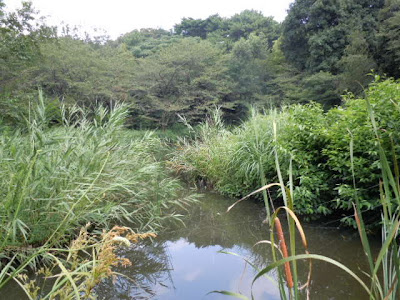Ishii read somewhere that Kencho-ji temple in Kita-Kamakura is a good place to see bush clover. Our route took us past Haruki-san's kimono exhibit so of course we took a little detour. Haruki and his wife were so gracious. They remembered my name! He pronounces "Kathy" the same way Yuuko Kaji does, with a very soft "th" that makes me feel all warm and fuzzy.
Ishii was wearing a lovely sashiko vest for the occasion, a long duster she spent a year creating. I wish I had taken some closeup pictures so you could see her exquisite craftsmanship. I, on the other hand, had spent the morning shelving books at the base thrift shop in a sleeveless shirt and found a ratty cardigan in the trunk of my car to cover my bare shoulders, something I feel as compelled to do when I am out and about in Japan as when I visited the Vatican at the age of fifteen. (As the day grew warmer, the sweater grew increasingly loathsome. I'm going to abandon it at the thrift shop the next time I shelve books.)
 |
| Karamon at Kencho-ji |
Kencho-ji, constructed in the 13th century, is the oldest Zen training monastery in Japan -- surely you've heard this before -- and the first-ranked of the five great Zen temples of Kamakura. This was my third visit since March 2007 yet I still took a dozen pictures of the statue of fasting Buddha and the dragon picture (unryu-zu) on the Hatto ceiling. No matter where you stand in the room, the dragon's eyes seem to follow you. This is quite eerie and, so far, impossible to capture in a photograph.
 |
| Fasting Buddha |
The map provided by the man at the ticket booth showed a garden near the rear of the temple grounds. This seemed like an obvious place to find bush clover so off we went. Except we skirted the building on the left when we should have marched directly through the building straight ahead and, lo and behold, we were behind the garden with no way to get through the tall hedge. That's when Ishii-san got that innocent look on her face that I really ought to recognize by now, the "As long as we're on this path, let's just take a little stroll and see what we can see" look. Those "little strolls" never fail to turn into arduous physical activity. Not that I'm complaining.
Today's "little stroll" took us eventually to the last building on the map, the Hanso-bo, which I think means "8,000 of the steepest steps you will ever climb". Seriously, even those cute 10-year old school children in their bright yellow caps were huffing and puffing by the time they reached the fourth or fifth flight of stairs. Japanese landscape designers must all take a special class in Deceptive Neverending Stairs because I can't count the number of times I've scampered up 80 steps only to discover another 80 steps across a short plateau and then yet another 80 steps camouflaged by a leafy maple tree. Wheeze, gasp.
This is the first time Ishii-san has been to the Hanso-bo. Her husband knows about those steps which is why I am here with her today and he's not.
More often than not there's some sort of visual reward for scaling all those steps and today is a more often rather than a not. Thank God.
The Hanso-bo is a shrine that was moved here from Shizuoka in 1890 to protect the temple in the valley below. The final stretch of hillside beneath the shrine is littered with statues of winged creatures called tengu which look like a cross between warrior angels and the Wicked Witch of the West's flying monkey minions.
There's a viewing platform next to the shrine which offers a lovely view of Mt. Fuji on a clear day. Today we couldn't see Mt. Fuji so I might just have to reprise that ascent. But you can be darn sure I'll borrow a couple of cell phones and a kid who's willing to scamper up those steps ahead of me to scout out the view.
 |
| Ishii-san and Tengu |
We spotted a patch of bush clover as we were working our way back toward the temple entrance but it had already finished blooming and that made us laugh. The bush clover seems relatively immune to the effects of the recent Typhoon Roke. Lots of other plants have leaves that are turning brown and shriveling up compliments of all the salt the typhoon carried from the sea to land.













































